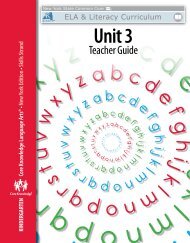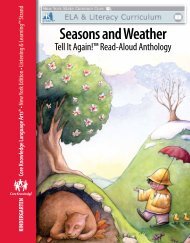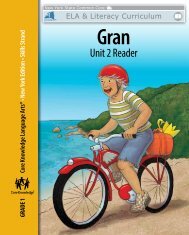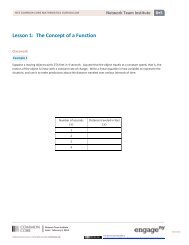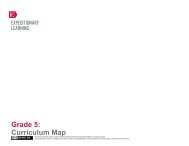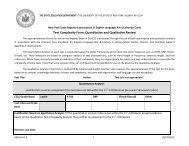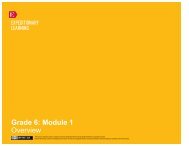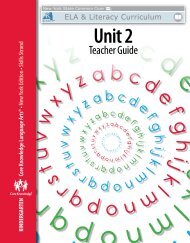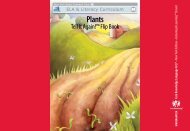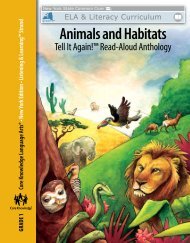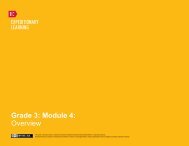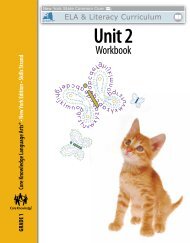A Review of the Current Research on Vocabulary Instruction - U.S. ...
A Review of the Current Research on Vocabulary Instruction - U.S. ...
A Review of the Current Research on Vocabulary Instruction - U.S. ...
Create successful ePaper yourself
Turn your PDF publications into a flip-book with our unique Google optimized e-Paper software.
Methodology<br />
Database<br />
In order to review <str<strong>on</strong>g>the</str<strong>on</strong>g> research since <str<strong>on</strong>g>the</str<strong>on</strong>g> NRP’s review, we used procedures defined by Cooper (1994) to identify<br />
<str<strong>on</strong>g>the</str<strong>on</strong>g> body <str<strong>on</strong>g>of</str<strong>on</strong>g> studies included in this syn<str<strong>on</strong>g>the</str<strong>on</strong>g>sis. These procedures included searching subject indices and citati<strong>on</strong>s,<br />
browsing, and footnote chasing (White, 1994). Computer searches <str<strong>on</strong>g>of</str<strong>on</strong>g> PsycINFO and ERIC databases from<br />
2002–2009 were c<strong>on</strong>ducted to locate appropriate studies. Descriptors for <str<strong>on</strong>g>the</str<strong>on</strong>g> computer search included “reading”<br />
and “vocabulary,” “vocabulary development,” or “oral language development.” The ERIC search yielded 342 results<br />
and PsycINFO yielded 297 results. Removing duplicates between <str<strong>on</strong>g>the</str<strong>on</strong>g> two databases generated a total <str<strong>on</strong>g>of</str<strong>on</strong>g> 324<br />
results. Studies were selected through a two-step process that began as a broad search to locate all potentially<br />
relevant research articles and became more restrictive as selecti<strong>on</strong> criteria were applied.<br />
Analysis<br />
Because this review builds <strong>on</strong> <str<strong>on</strong>g>the</str<strong>on</strong>g> work <str<strong>on</strong>g>of</str<strong>on</strong>g> <str<strong>on</strong>g>the</str<strong>on</strong>g> NRP, we adopted its criteria for including studies:<br />
1. The study must have been relevant to instructi<strong>on</strong> <str<strong>on</strong>g>of</str<strong>on</strong>g> vocabulary and/or oral language development.<br />
2. The study must have been published in a scientific journal.<br />
3. The study’s experimental design had to involve at least <strong>on</strong>e treatment and an appropriate c<strong>on</strong>trol group or<br />
needed to have <strong>on</strong>e or more quasi-experimental variables with variati<strong>on</strong>s that served as comparis<strong>on</strong>s between<br />
treatments (NRP, 2000).<br />
Bey<strong>on</strong>d <str<strong>on</strong>g>the</str<strong>on</strong>g> NRP’s criteria, this review added:<br />
4. The study must have been published between 2001 and 2009.<br />
5. The study must have included student participants in pre–K, K, 1, 2, or 3, or any combinati<strong>on</strong> <str<strong>on</strong>g>the</str<strong>on</strong>g>re<str<strong>on</strong>g>of</str<strong>on</strong>g>.<br />
Applying <str<strong>on</strong>g>the</str<strong>on</strong>g>se criteria reduced <str<strong>on</strong>g>the</str<strong>on</strong>g> number <str<strong>on</strong>g>of</str<strong>on</strong>g> applicable studies to 14. Using a code sheet based <strong>on</strong> two published<br />
syn<str<strong>on</strong>g>the</str<strong>on</strong>g>ses (Klingner & Vaughn, 1999), extensive coding was c<strong>on</strong>ducted to organize pertinent informati<strong>on</strong> from each<br />
study. The code sheet allowed reviewers to record informati<strong>on</strong> <strong>on</strong> <str<strong>on</strong>g>the</str<strong>on</strong>g> coder, participants (e.g., participants’ ages)<br />
and <str<strong>on</strong>g>the</str<strong>on</strong>g>ir setting; <str<strong>on</strong>g>the</str<strong>on</strong>g> study’s purpose, research design, and methodologies; and descripti<strong>on</strong>s <str<strong>on</strong>g>of</str<strong>on</strong>g> <str<strong>on</strong>g>the</str<strong>on</strong>g> interventi<strong>on</strong>, <str<strong>on</strong>g>the</str<strong>on</strong>g><br />
measure, observati<strong>on</strong>s, and findings. When a study presented multiple purposes, sets <str<strong>on</strong>g>of</str<strong>on</strong>g> participants, and results,<br />
<strong>on</strong>ly those purposes, etc. that pertained to this syn<str<strong>on</strong>g>the</str<strong>on</strong>g>sis were coded and analyzed.<br />
Results<br />
See <str<strong>on</strong>g>the</str<strong>on</strong>g> appendix for an overview <str<strong>on</strong>g>of</str<strong>on</strong>g> <str<strong>on</strong>g>the</str<strong>on</strong>g> research findings. Examinati<strong>on</strong> <str<strong>on</strong>g>of</str<strong>on</strong>g> <str<strong>on</strong>g>the</str<strong>on</strong>g> 14 studies included in this syn<str<strong>on</strong>g>the</str<strong>on</strong>g>sis<br />
indicates c<strong>on</strong>vergence <strong>on</strong> <str<strong>on</strong>g>the</str<strong>on</strong>g> following research <str<strong>on</strong>g>the</str<strong>on</strong>g>mes: (a) frequency <str<strong>on</strong>g>of</str<strong>on</strong>g> exposure to targeted vocabulary<br />
augments children’s understanding <str<strong>on</strong>g>of</str<strong>on</strong>g> word meanings and <str<strong>on</strong>g>the</str<strong>on</strong>g>ir use <str<strong>on</strong>g>of</str<strong>on</strong>g> targeted words, (b) explicit instructi<strong>on</strong><br />
increases word learning, and (c) language engagement through dialogue and/or questi<strong>on</strong>ing strategies during a<br />
read-aloud enhances word knowledge.<br />
3



